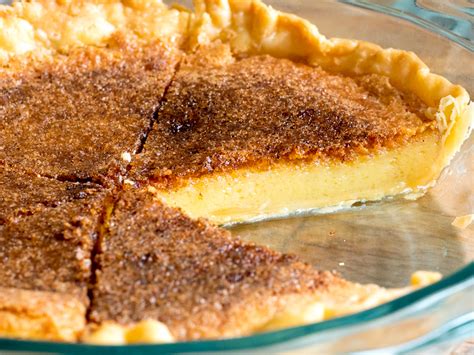
Iowa’s Vinegar Pie, a Depression-era dessert with a tangy flavor profile, is sparking debate among food enthusiasts, as some find its unique tartness delightful while others remain unconvinced of its appeal.
A humble pie born from necessity during times of scarcity, Vinegar Pie offers a taste of history, but its unconventional ingredients and sharp taste have made it a divisive dish, even within Iowa itself. While some Iowans cherish it as a comforting reminder of their heritage, others struggle to appreciate its distinctive flavor. “It’s kind of a lost art,” says chef and owner of Goldfinch in Des Moines, Alex Hall.
A Taste of History: The Origins of Vinegar Pie
Vinegar Pie’s roots lie in the resourcefulness of home cooks during the Great Depression and periods of limited access to fresh ingredients. When traditional pie fillings like fruit were unavailable or too expensive, resourceful bakers turned to vinegar as a substitute. The vinegar, combined with sugar, eggs, butter, and spices, creates a custard-like filling with a distinct tartness that mimics the flavor of fruit pies.
The pie’s historical significance is undeniable, representing a time when frugality and creativity were essential in the kitchen. Recipes for Vinegar Pie have been passed down through generations, often with each family adding their own unique twist to the basic formula. These variations reflect the diverse tastes and preferences of different communities within Iowa and beyond.
The Recipe: A Balance of Tart and Sweet
The basic recipe for Vinegar Pie is surprisingly simple, requiring readily available ingredients. While variations abound, a typical recipe includes:
- Vinegar: Usually white vinegar or apple cider vinegar, providing the signature tartness.
- Sugar: To balance the vinegar’s acidity and create a sweet base.
- Eggs: For richness and to create a custard-like texture.
- Butter: Adds flavor and contributes to the pie’s creamy consistency.
- Flour or Cornstarch: As a thickening agent.
- Spices: Such as vanilla extract, nutmeg, cinnamon, or cloves, to enhance the flavor profile.
The ingredients are combined and poured into an unbaked pie crust, then baked until the filling is set and golden brown. The baking process mellows the vinegar’s sharpness, resulting in a tangy yet balanced flavor.
Why Vinegar Pie Divides Opinion
The divisive nature of Vinegar Pie stems from its unconventional flavor profile. The tartness of the vinegar is not for everyone, and some find it overpowering or simply unappetizing. Those accustomed to sweeter, fruit-filled pies may find the tangy taste of Vinegar Pie to be a jarring departure from the norm.
However, many appreciate the pie’s unique flavor and find it to be a refreshing alternative to traditional desserts. The tartness can be particularly appealing to those who enjoy sour or acidic flavors. Others are drawn to the pie’s historical significance and the nostalgia it evokes.
“Some people try it and they’re like, ‘Oh, that’s interesting,'” Hall states. “And some people try it and they’re like, ‘I don’t get it.'” This sentiment encapsulates the pie’s polarizing effect.
Modern Interpretations and Revival Efforts
Despite its divisive reputation, Vinegar Pie is experiencing a resurgence in popularity, thanks to chefs and bakers who are embracing traditional recipes and experimenting with modern interpretations. These contemporary versions often incorporate higher-quality ingredients, refined techniques, and creative flavor combinations.
Some chefs are using different types of vinegar, such as sherry vinegar or balsamic vinegar, to add complexity and depth to the pie’s flavor. Others are incorporating fresh herbs, citrus zest, or spices to create unique variations. Some modern recipes also include a streusel topping or a glaze to enhance the pie’s texture and visual appeal.
Alex Hall is one such chef, stating, “It’s kind of a lost art,” when referring to the pie and its presence in modern cuisine. By featuring Vinegar Pie on their menus, restaurants and bakeries are introducing new audiences to this historic dessert and helping to preserve its legacy.
Vinegar Pie Beyond Iowa
While Vinegar Pie is often associated with Iowa, its popularity extends beyond the state’s borders. Similar vinegar-based pies can be found in other regions of the United States, particularly in areas with a strong tradition of pioneer cooking. These pies often go by different names, such as “Desperation Pie” or “Mock Apple Pie,” but they share the same basic concept of using vinegar as a substitute for fruit.
The pie’s enduring appeal speaks to the resourcefulness and ingenuity of home cooks who were able to create delicious desserts even in the face of adversity. Vinegar Pie is a testament to the power of culinary tradition and the ability of food to connect us to our past.
The Social and Cultural Significance
Vinegar Pie represents more than just a dessert; it embodies the values of resourcefulness, resilience, and community that were essential during times of hardship. The pie’s simple ingredients and straightforward preparation reflect the practical mindset of those who relied on it as a staple.
The act of making and sharing Vinegar Pie became a way for families and communities to come together and celebrate their shared heritage. Recipes were passed down through generations, serving as a tangible link to the past. The pie’s unique flavor became associated with memories of family gatherings, holidays, and special occasions.
In modern times, Vinegar Pie serves as a reminder of the importance of preserving culinary traditions and appreciating the ingenuity of our ancestors. It is a symbol of the resourcefulness and resilience that helped communities overcome challenges and build a better future.
The Future of Vinegar Pie
The future of Vinegar Pie is uncertain, but its recent resurgence suggests that it will continue to be enjoyed by those who appreciate its unique flavor and historical significance. As more chefs and bakers experiment with modern interpretations of the recipe, the pie is likely to evolve and adapt to changing tastes.
Whether it remains a niche dessert or gains wider popularity, Vinegar Pie will undoubtedly continue to spark debate and intrigue. Its divisive nature is part of its charm, and it serves as a reminder that not all culinary traditions are universally loved.
Ultimately, the fate of Vinegar Pie rests in the hands of those who are willing to embrace its unconventional flavor and appreciate its historical significance. As long as there are those who are willing to bake and share this unique dessert, its legacy will endure.
FAQ: Iowa’s Vinegar Pie
1. What exactly is Vinegar Pie?
Vinegar Pie is a traditional American dessert, particularly associated with Iowa and the Midwest, that uses vinegar as a primary flavoring agent instead of fruit. It’s a custard-based pie, typically made with vinegar (usually white or apple cider vinegar), sugar, eggs, butter, and spices, thickened with flour or cornstarch. The result is a pie with a distinct tart and tangy flavor.
2. Why is vinegar used in a pie?
The use of vinegar in pie dates back to times of scarcity, particularly the Great Depression, when fresh fruits were not readily available or were too expensive. Vinegar provided an accessible and affordable way to create a pie filling with a tangy taste reminiscent of fruit pies. It was a creative substitute that allowed people to enjoy a dessert even when traditional ingredients were scarce.
3. What does Vinegar Pie taste like?
Vinegar Pie has a unique flavor profile characterized by its tartness. The vinegar provides a tangy taste that is balanced by the sweetness of sugar. The texture is similar to a custard pie, with a creamy and smooth filling. The spices, such as vanilla, nutmeg, or cinnamon, add warmth and complexity to the overall flavor.
4. Is Vinegar Pie difficult to make?
No, Vinegar Pie is relatively simple to make, requiring basic baking skills and readily available ingredients. The recipe typically involves mixing the ingredients together, pouring the mixture into an unbaked pie crust, and baking until the filling is set. While the recipe itself is straightforward, achieving the right balance of tartness and sweetness may require some experimentation.
5. Where can I find Vinegar Pie?
Vinegar Pie is most commonly found in Iowa and other Midwestern states, where it is often made at home or served in local restaurants and bakeries that specialize in traditional cuisine. While not as widely available as other types of pie, Vinegar Pie can sometimes be found in restaurants or bakeries that feature heritage or vintage recipes. Alternatively, you can easily find recipes online and try making it yourself.
In-Depth Analysis: The Psychology of Taste and Vinegar Pie
The human perception of taste is a complex phenomenon involving a variety of factors, including genetics, cultural background, and personal experiences. The five basic tastes – sweet, sour, salty, bitter, and umami – interact in intricate ways to create the flavors we experience. Vinegar Pie, with its dominant sourness, challenges our taste preferences and highlights the subjective nature of culinary enjoyment.
The Role of Sourness
Sourness is often associated with spoiled or unripe foods, triggering an aversion response in many people. This aversion is thought to be an evolutionary adaptation that protects us from consuming potentially harmful substances. However, sourness can also be a desirable taste when balanced with other flavors, such as sweetness or saltiness.
In the case of Vinegar Pie, the tartness of the vinegar is a defining characteristic, but it is not the only flavor present. The sugar in the recipe helps to temper the sourness, creating a balance that some find appealing. The addition of spices, such as vanilla or nutmeg, further enhances the complexity of the flavor profile.
Cultural Influences
Our cultural background plays a significant role in shaping our taste preferences. Foods that are considered delicacies in one culture may be deemed unappetizing in another. The acceptance or rejection of Vinegar Pie may be influenced by cultural norms and traditions related to food.
In Iowa and other Midwestern states, Vinegar Pie is often seen as a comforting reminder of the past, evoking memories of family gatherings and simpler times. For those who grew up eating Vinegar Pie, its unique flavor may be associated with positive emotions and nostalgia.
Personal Experiences
Our individual experiences with food also influence our taste preferences. A negative experience with a particular food can create a lasting aversion, while a positive experience can lead to a lifelong fondness. The first time someone tries Vinegar Pie may determine their future opinion of it.
If someone’s initial experience with Vinegar Pie is unpleasant, they may be less likely to try it again. However, if they approach the pie with an open mind and appreciate its historical significance, they may be more receptive to its unique flavor.
The Resurgence of Interest in Vintage Recipes
The recent resurgence of interest in Vinegar Pie reflects a broader trend of rediscovering and celebrating vintage recipes. As people become more interested in food history and the culinary traditions of their ancestors, they are seeking out unique and forgotten dishes.
Vinegar Pie, with its humble origins and unconventional ingredients, embodies the resourcefulness and ingenuity of home cooks from the past. By recreating these vintage recipes, people are connecting with their heritage and gaining a new appreciation for the culinary skills of previous generations.
The Impact of Social Media and Food Blogging
Social media platforms and food blogs have played a significant role in the revival of Vinegar Pie. These online communities provide a space for people to share recipes, discuss culinary traditions, and express their opinions about different foods.
Food bloggers have helped to popularize Vinegar Pie by sharing their own recipes and stories about the pie’s history. Social media platforms have allowed people to share photos of their Vinegar Pie creations and connect with others who share their interest in this unique dessert.
Modern Variations and Innovations
As Vinegar Pie gains wider recognition, chefs and bakers are experimenting with modern variations and innovations. These contemporary versions often incorporate higher-quality ingredients, refined techniques, and creative flavor combinations.
Some chefs are using different types of vinegar, such as sherry vinegar or balsamic vinegar, to add complexity and depth to the pie’s flavor. Others are incorporating fresh herbs, citrus zest, or spices to create unique variations. Some modern recipes also include a streusel topping or a glaze to enhance the pie’s texture and visual appeal.
The Ethical Considerations of Food Waste
In an era of increasing awareness of food waste, Vinegar Pie’s origins as a resourceful way to create a dessert from readily available ingredients resonates with many. The pie serves as a reminder that delicious and satisfying meals can be made with simple, inexpensive ingredients, reducing the need for processed or imported foods.
By embracing the principles of resourcefulness and frugality that underlie Vinegar Pie, we can reduce food waste and promote a more sustainable food system.
The Culinary Tourism Angle
For travelers interested in experiencing authentic regional cuisine, Vinegar Pie offers a unique taste of Iowa’s culinary heritage. Visiting local restaurants and bakeries that serve Vinegar Pie can provide a glimpse into the state’s history and culture.
Culinary tourism is becoming increasingly popular as people seek out unique and authentic food experiences. Vinegar Pie, with its distinctive flavor and historical significance, can be a draw for visitors interested in exploring Iowa’s culinary landscape.
The Future of Vinegar Pie: A Balancing Act
The future of Vinegar Pie depends on a delicate balance between preserving its historical integrity and adapting it to modern tastes. While some purists may insist on sticking to the traditional recipe, others may be more open to experimentation and innovation.
Ultimately, the success of Vinegar Pie will depend on its ability to appeal to a wider audience without sacrificing its unique character. By embracing both tradition and innovation, Vinegar Pie can continue to be enjoyed by generations to come.
Conclusion: More Than Just a Pie
Vinegar Pie is more than just a dessert; it is a symbol of resourcefulness, resilience, and culinary tradition. Its unique flavor, born from necessity, continues to spark debate and intrigue, reminding us of the subjective nature of taste and the power of food to connect us to our past. Whether you love it or hate it, Vinegar Pie is a testament to the ingenuity of home cooks who were able to create delicious meals even in the face of adversity. As long as there are those who are willing to bake and share this unique dessert, its legacy will endure.









